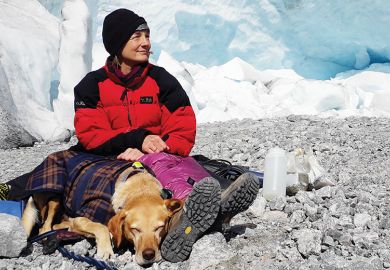Igneous petrology, from the Latin ignis (fire) and Greek petros (stone), is not as esoteric as it first sounds. Anyone who has seen an active lava flow on television or, even better, in real life has witnessed igneous petrology at work. The molten material, called magma, running as a stream of lava, is destined ultimately to cool and crystallise into solid rock. Every year, thousands of holiday-makers who bask in the sun on black-sand beaches in the Canary Islands or Hawaii are lying on the flanks of massive volcanoes, formed mostly from crystallised magma. Indeed, the continents themselves are made up largely from igneous rocks that have cooled from magma. So are the floors of the world's ocean basins. And igneous processes occur beyond the Earth. All the terrestrial planets show evidence of igneous activity at their surface and internally.
To understand how magmas are generated and emplaced, igneous petrologists draw on expertise from other branches of science including physical chemistry, thermodynamics, fluid dynamics and mechanics. All of this must be put into context from observations made in the field. So used are petrologists to this 21st-century modus operandi that it is easy to forget it was not always thus. Even 50 years ago, life for the working petrologist was in many ways far simpler, although complicated in other ways by internal conflicts surrounding, for example, rock-classification schemes.
Mind over Magma: The Story of Igneous Petrology chronicles the development of one of the more intellectually challenging branches of geological science, from ancient descriptions of volcanic eruptions to recent thoughts on geochemistry and magma dynamics. As the first and only book of its kind, Mind over Magma is important for its historical and sociological insight into the subject, but also for reference material. It is probably worth buying for the bibliography alone. As for the potential readership, the book is clearly a scholarly work and not for the general reader of popular science books.
Thirty chapters are divided chronologically into groupings that summarise what Davis Young sees as the major developmental eras in the history of the subject.
We begin with a survey of early ideas on volcanism from antiquity to the enlightenment (those wishing for a more extensive history are directed to F. D. Adams' Birth and Development of the Geological Sciences ). Young reminds us that the petrological microscope, now regarded as a relatively humble instrument of torture by first-year geology undergraduates, was considered a state-of-the-art piece of kit that saved the fledgling discipline from stagnation.
The next big step, arguably the one that set petrology on the road to becoming a modern science, was the introduction of experiments, guided by principles of physical chemistry and thermodynamics. The work of N. L.
Bowen and others at the Geophysical Laboratory in Washington DC, stands out here. On the back of these insights into the cooling and crystallisation behaviour of magmas came developments in instrumentation, including spectroscopic methods to determine rock composition, followed by the application of radiogenic isotopes. The latter has proved powerful in unravelling a wide range of igneous processes, including age dating.
Since the 1980s, the application of fluid dynamics has helped revolutionise our understanding of magma transport and emplacement, yet this has not been without controversy, due largely to the nature of the material under investigation. For a start, real magma chambers are not glass tanks, real magmas are not simple fluids and their flows are rate dependent. The incursion of physics into petrology added rigour and propelled the subject forwards in ways unachievable by chemists working alone.
Wherever you turn, there is something of interest in this exquisitely researched text. I shall highlight a few areas that caught my eye. First, regarding classification, Arthur Holmes noted the luxuriant growth in nomenclature in the early 20th century, during which too many petrologists would name a rock after some obscure location. Add to this their penchant for gathering chemical data, rather than spending time doing quantitative mineralogy, and the subject was soon suffering from terminological meltdown. Some forward-looking thinkers decided enough was enough. They invented the CIPW norm (named after its US founders Cross, Iddings, Prisson and Washington), which was a masterstroke of logic but Kafkaesque to apply.
A certain rock might now belong to class II, the dosalanes, in the fifth order germanare, the second rang monzonase, the third subrang monzonose, the second grad monzonate, and so on. The more useful aspects of the CIPW norm have been preserved, but much was left to wither.
The second area of excellence in the book relates to the emplacement of magmas within the solid earth, a topic ignored by many petrologists who place composition above geometry. The honour of being "father of igneous mechanics" must go to G. K. Gilbert. His classic 1877 text on magma emplacement in the Henry Mountains, Utah, still feels alarmingly contemporary, and his comment that intruding magma is "constantly solving a problem of least force" puts into words what modern numerical models are only just starting to prove. But even mechanics succumbed to terminology.
For an igneous mass similar in shape to a cactus, we read that the eponymous cactolith is a "quasihorizontal chonolith composed of anastamosing ductoliths whose distal ends curl like a harpolith, thin like a sphenolith, or bulge discordantly like an akmolith or an etmolith". If J. K. Rowling is ever short on monster names, she knows where to look.
What of the future? Young gives some thought to this at the end of the book, but it is clear that future petrologists will have to get to grips with examination of planetary material. Igneous rocks have been collected from the moon and as meteorites, and a sample-return mission from Mars, Venus or an asteroid is surely not far off. But we should remember that much of the igneous activity seen in the outer solar system is not hot but cold. Indeed, as inhabitants of the inner solar system we are thermal chauvinists. Perhaps cryomagmatism will turn out to be the norm in the universe and hot magmas a curio?
Some may find the book a bit light on the contributions to the subject of physical volcanologists. Also, elevating simple geochemical mass balance summations to the status of mathematical modelling may raise the odd eyebrow among geophysical fluid dynamicists. To this end, proper mathematics involving fractional calculus to capture nonlocal effects, computing and scientific visualisation is destined to play an ever-more pivotal role in unravelling the true behaviour of magmas as complex multiphase flows where field observations, no matter how detailed, only ever capture the final freezing event.
Mind over Magma is a landmark publication. Any petrologist who chooses not to read this book will be doing themselves, and their students, a great disservice.
Nick Petford is reader in igneous mechanics, Kingston University.
Mind over Magma: The Story of Igneous Petrology
Author - Davis A. Young
Publisher - Princeton University Press
Pages - 686
Price - £46.95
ISBN - 0 691 109 1
Register to continue
Why register?
- Registration is free and only takes a moment
- Once registered, you can read 3 articles a month
- Sign up for our newsletter
Subscribe
Or subscribe for unlimited access to:
- Unlimited access to news, views, insights & reviews
- Digital editions
- Digital access to THE’s university and college rankings analysis
Already registered or a current subscriber?



